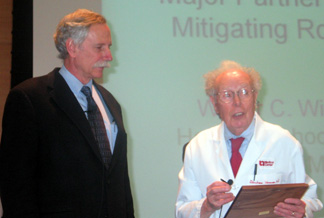 |
Walter Willett, M.D., Dr.P.H., left, with UNMC’s Denham Harman, M.D., Ph.D. |
On Friday, the nutrition expert frequently cited internationally for his expertise on foods, fats and diets, shared his ideas on an optimal diet before presenting the fourth annual Denham Harman, M.D., Ph.D., Lectureship in Biomedical Gerontology to a large crowd in the Durham Research Center Auditorium.
Dr. Willett, professor of epidemiology and nutrition and chairman of the Department of Nutrition at Harvard School of Public Health, has published more than 900 articles, primarily addressing lifestyle risk factors for heart disease and cancer, and is known for his criticism of the United States Department of Agriculture Food Guide Pyramid, a general outline of daily diet recommendations. Based on years of research, Dr. Willett created his own food pyramid.
“It’s hard to put the optimal diet into one sentence because we have understood for many years that balance and variety are very important so there’s no single panacea.But there are some basic elements of the diet that are really pretty important though.”
At the top of the list, he said, is keeping the total number of calories in balance with a person’s level of physical activity. “For most of us that means we need more physical activity and fewer calories,” he said.
A diet low in transfats also is important, he said. “It’s very clear there are some types of fats that are really nasty and transfat is by far the worst,” he said.
Even margarines, long associated with transfats, are available now in trans-free forms, he said. Still, he uses such oils as corn, soybean, canola and olive, which help bring down cholesterol levels, as well as the risk of heart disease and Type 2 diabetes.
The type of carbohydrate also is important, he said, promoting whole grains and high-fiber foods such as whole grain breads, pasta and brown rice. “Refined carbohydrates are really metabolically no better than refined sugar,” he said.
Dr. Willett doesn’t endorse overindulging on red meat, particularly if it’s processed. He does advocate a combination of fish, poultry, nuts, beans and soy products, and plenty of fruits and vegetables.
Although some calcium is beneficial, he says more research is needed to determine how much is necessary in one’s diet. Contrary to popular belief, he said, high dairy consumption does not lower the risk of fractures. “It’s clear for fracture prevention, Vitamin D is a much more important factor than calcium,” he said, as well as such physical activity as walking.
Dr. Willett has focused much of his work over the past 25 years on the development of methods, using both questionnaire and biochemical approaches, to study the effects of diet on the occurrence of major diseases. He has applied these methods starting in 1980 in the Nurses’ Health Studies I and II and the Health Professionals’ Follow-up Study. The dietary assessment of nearly 300,000 men and women is providing detailed information on the long-term health consequences of food choices.
“Dr. Harman’s writing and research has figured quite prominently in the research that we’ve done,” Dr. Willett said.
The Denham Harman, M.D., Ph.D. Lectureship in Biomedical Gerontology was established in 2002 by the University of Nebraska Foundation to honor the scientific achievements of Dr. Harman, UNMC emeritus professor of internal medicine, known internationally as the father of the free radical theory of aging, who also discovered the role of antioxidants (vitamins C, E and beta-carotene), in fighting heart disease and cancer.
Dr. Harman’s research on aging is based on the theory he proposed in 1954 – that free radicals, highly reactive molecules freed in the normal chemical processes of living, cause aging and disease through their destructive actions in cells and tissues. At first, his theory was ridiculed and dismissed by many in the scientific community. It gained acceptance in the 1980s and now is considered a theory of aging.
His work at UNMC also established the role of antioxidants in fighting cancer and heart disease. His research has led to international recognition and awards.